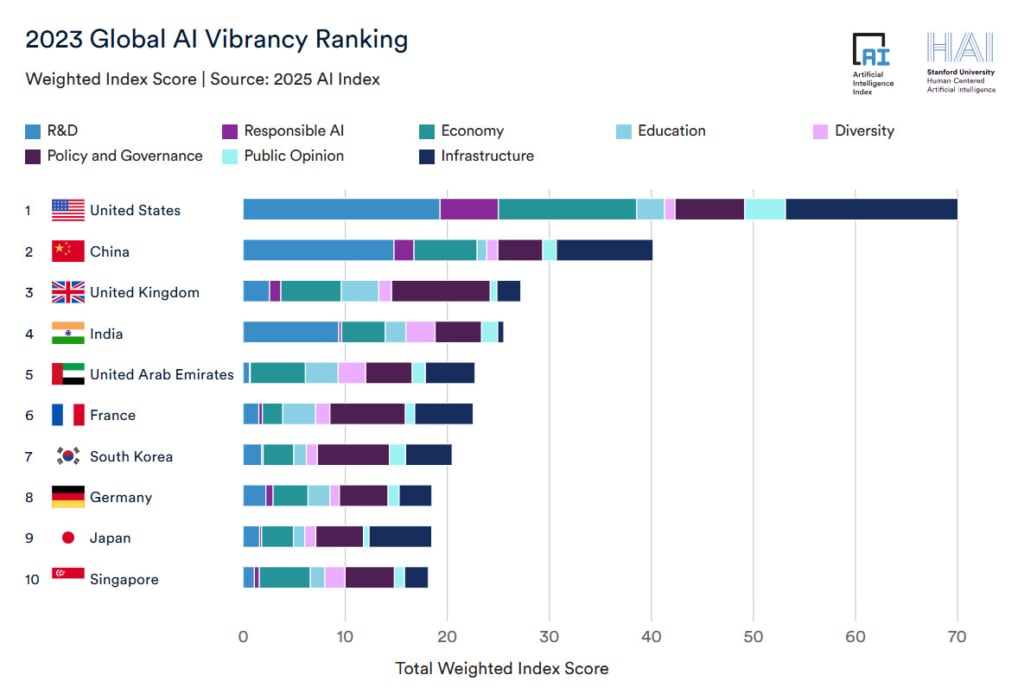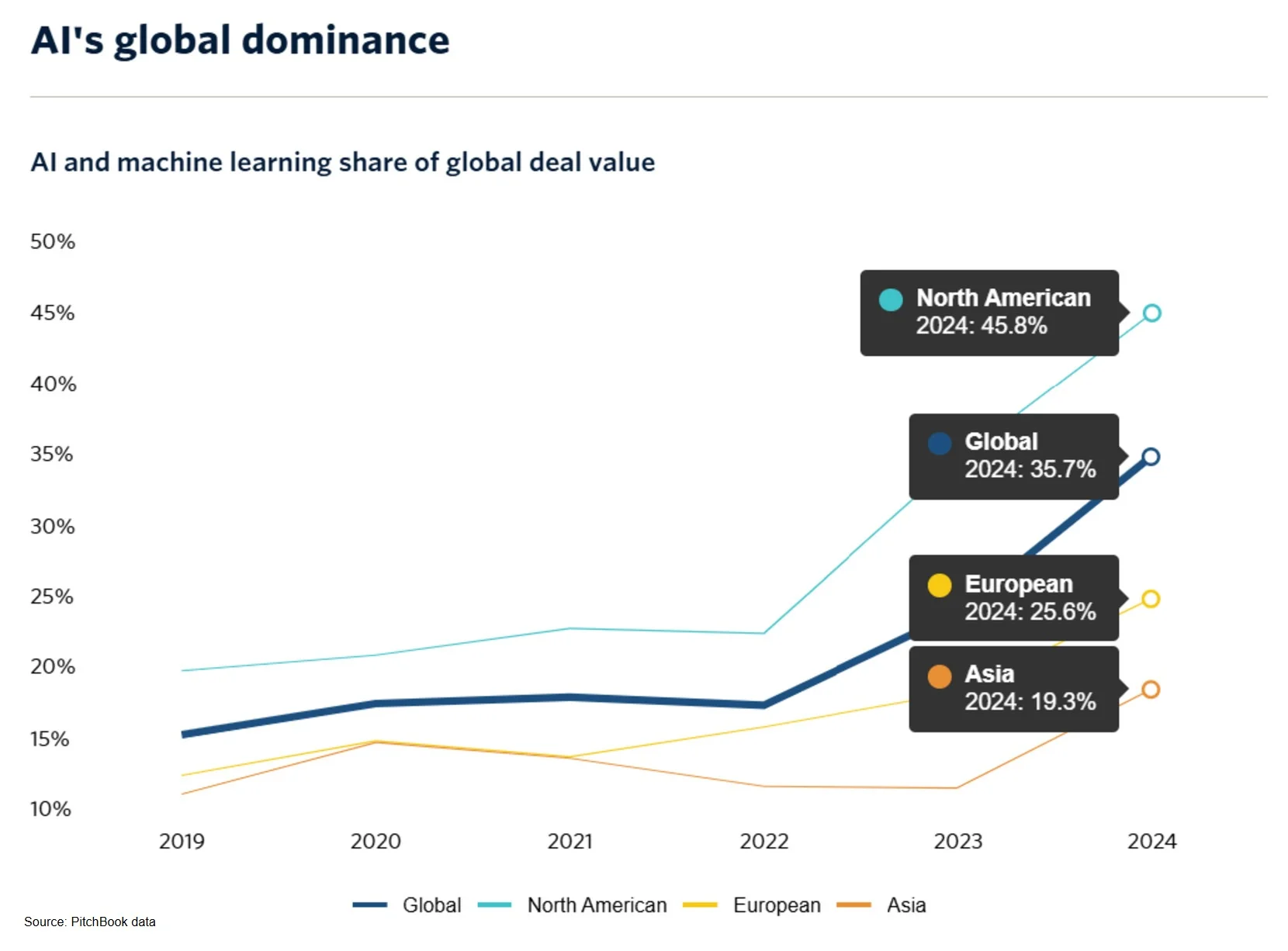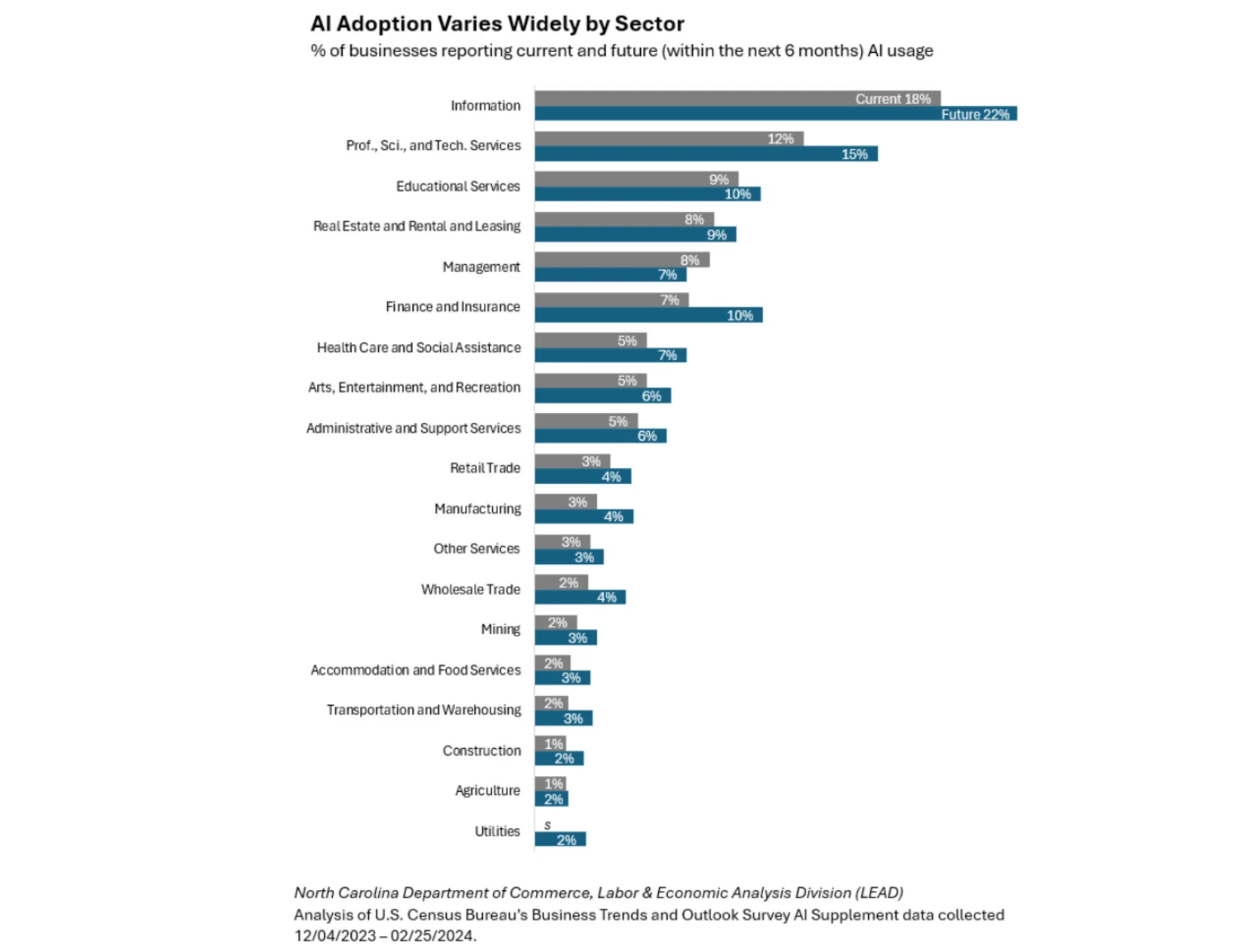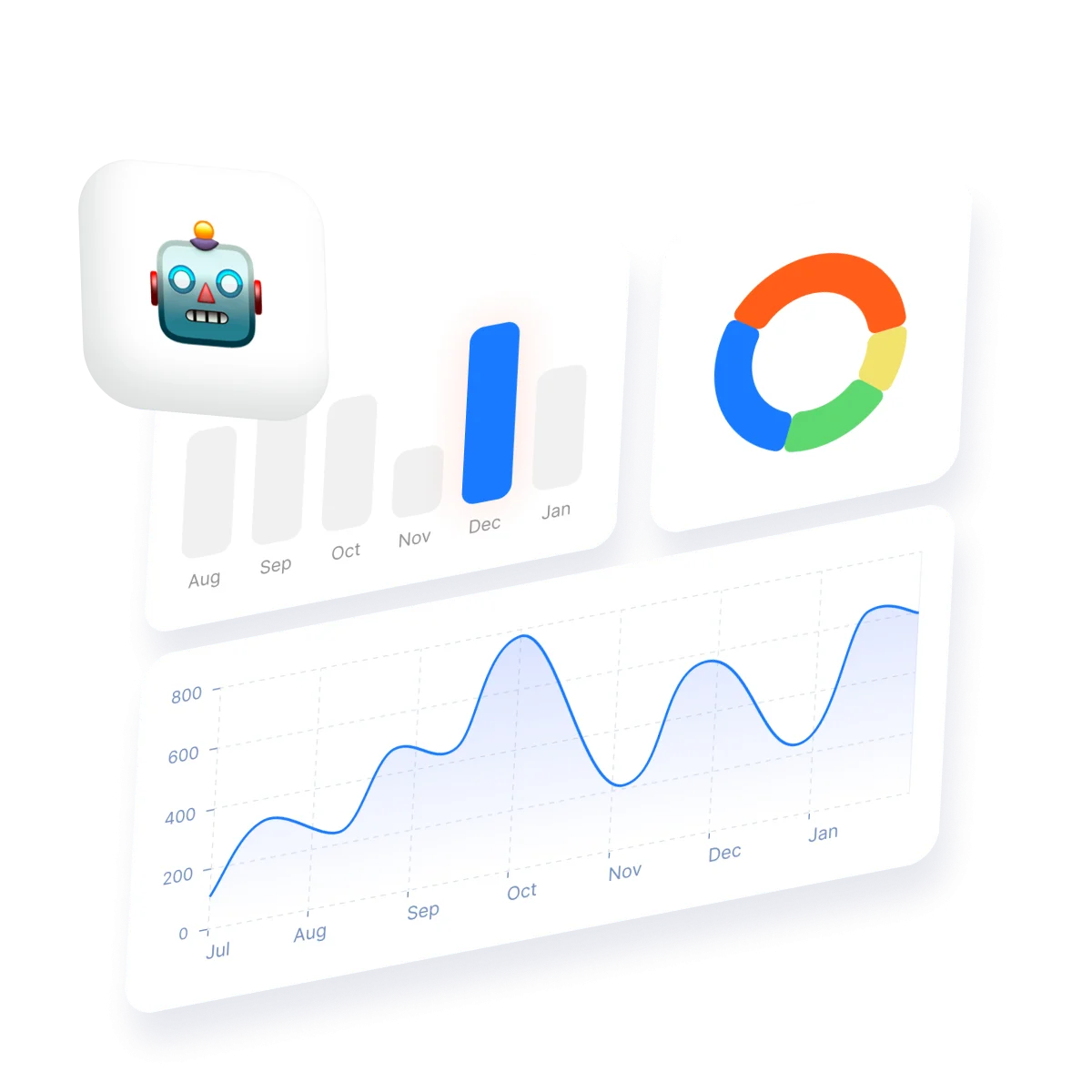Artificial Intelligence has evolved from a theoretical concept into a transformative force that is reshaping industries, businesses, and even daily life. In recent years, AI has become a pivotal technology in everything from healthcare to marketing, finance to customer service. As AI continues to grow and evolve, its usage is expanding at an unprecedented rate, both among businesses and individual users.
With AI-driven innovations such as machine learning, natural language processing, and generative AI, the technology is revolutionizing how we interact with the world around us. This article explores the latest AI usage statistics, trends, and applications, shedding light on how businesses and individuals are leveraging AI solutions.
Key AI Statistics
How fast is the AI industry growing?
The adoption of AI has been growing at a remarkable pace, both among businesses and individual users. As AI technology becomes increasingly accessible, its applications are expanding across various sectors. This widespread adoption is shaping the future of industries and creating new business opportunities.
The adoption rate of generative AI, currently at 39.4%, is advancing more rapidly than that of previous technologies such as PCs and the internet. Three years after the personal computer’s mass introduction, its adoption rate was only 20%, a figure similar to the internet’s adoption rate two years after its launch.
Over the past six years, AI adoption in organizations has remained around 50 percent. However, the 2024 survey by McKinsey & Company shows a significant increase, with adoption rising to 72 percent. Generative AI adoption has also seen strong growth, reaching 65 percent, reflecting a global surge in interest.
How many people use AI?
As of August 2024, nearly 40% of U.S. adults aged 18 to 64 had used generative AI to some extent. About 1/3 of respondents reported using it daily or at least a few times per week. Interestingly, AI usage was slightly higher at home (32.6%) than at work (28.1%), but daily use was more common at work (10.6%) compared to home (6.4%).
While many individuals may not realize it, AI is already embedded in everyday life. From virtual assistants like Siri and Alexa to personalized recommendations on streaming platforms such as Netflix and Spotify, millions of people interact with AI daily. As AI technology continues to mature, we can expect even greater adoption across businesses of all sizes and industries.
AI popularity by region
AI’s popularity varies across different regions, with some areas experiencing rapid adoption, while others are still catching up. The Global Vibrancy Tool from the Stanford Institute for Human-Centered AI ranks the United States as the global leader in artificial intelligence, followed by China and the United Kingdom. Analyzing data from 36 countries, the tool highlights that the U.S. leads in key areas like machine learning models, private AI investment, and responsible AI research, with China remaining a distant second.
Here’s the overview of the top 10 countries from the list:

Global AI Market Size & Growth Projections
Artificial Intelligence (AI) has moved beyond the realm of science fiction to become a driving force in the technological landscape. From automating tasks to enhancing decision-making, AI is transforming industries across the globe. Understanding the size of the AI market and its projected growth is crucial for businesses and investors aiming to navigate the rapidly changing technological environment.
How much is the AI industry worth?
As of 2024, the global AI industry is valued at approximately $638.23 billion. Key advancements in machine learning, natural language processing, and computer vision continue to fuel this growth, with applications ranging from automated customer service to advanced medical diagnostics.
The investment in AI is robust, with both large tech companies and startups investing heavily in AI research and development. Here’s the list of top 5 countries that invested in the AI the most in the last years:
- United States: $328.5 billion (2019–2023), $67.9 billion in 2023 (+65.94% from 2019)
- China: $132.7 billion (2019–2023), $15.1 billion in 2023 (down ~33% from 2019)
- United Kingdom: $25.5 billion (2019–2023)
- India: $16.1 billion (2019–2023)
- Germany: $14.3 billion (2019–2023)
Looking ahead, the AI market is projected to reach $3,680.47 billion by 2034. The United States is expected to lead globally, with an estimated market size of $851.46 billion by 2034.
As AI continues to evolve, it will play an even more critical role in driving innovation and economic growth, making it one of the most influential industries in the world. Businesses, investors, and entrepreneurs should closely monitor these trends, as the AI market presents unparalleled opportunities for innovation and success.
AI investment trends
The increasing demand for artificial intelligence technologies has resulted in a surge of investments in AI startups, research, and development. Both private and public sectors are investing heavily in AI, recognizing its potential to revolutionize industries ranging from healthcare to manufacturing.
AI investments have skyrocked in 2024. Over the year, AI and machine learning startups secured a record-breaking $131.5 billion in venture capital funding, which equals to the 1/3 of all VC dollars. This surge, driven by several billion-dollar deals, reflects growing investor confidence in AI’s transformative potential.

AI investment trends are clearly on the rise, with billions of dollars being pumped into AI research, development, and startups.
Generative AI, such as OpenAI’s ChatGPT, is attracting a large share of this funding, as companies and investors see the vast potential in automating creative tasks and transforming industries. Read our article to learn more about ChatGPT usage statistics.
AI Usage Statistics Across Industries
Different AI-powered solutions, like website chatbots and virtual assistants, have become common for many businesses, providing quick and accurate responses to customer queries, reducing waiting times, and enabling 24/7 support.
The business world has quickly recognized AI’s potential to enhance efficiency, automate processes, and drive innovation. As of 2025, approximately 78% of companies worldwide use AI in at least one business function, according to a survey from Hostinger.
AI integration varies across industries, with some sectors embracing the technology more rapidly than others. Here’s a look at the adoption rate in key industries.
Education
The integration of artificial intelligence (AI) in education has seen a significant rise, with approximately 43% of higher education students utilizing AI-powered tools to enhance their learning experiences. These tools offer personalized study recommendations and efficient grading systems, contributing to a more tailored educational journey.
In the United States, the adoption of AI tools like ChatGPT among students has notably increased. A recent survey indicates that 26% of teens used ChatGPT for schoolwork in 2024, doubling from 13% in 2023. This trend reflects a growing reliance on AI for academic assistance, with students finding these tools beneficial for researching new topics and understanding complex concepts.
Healthcare
Artificial intelligence (AI) is making significant inroads into the healthcare sector, with a growing number of providers leveraging AI to enhance patient care. As of recent data, 12% of U.S. adults report that their healthcare providers utilize AI for diagnosis, treatment, or communication purposes. Looking ahead, there’s a strong expectation for AI’s expanding role, with the majority of the population anticipating that AI will play a more substantial part in healthcare within the next five years.
Public sentiment towards AI in healthcare is notably positive. A survey conducted in June 2023 revealed that 80% of Americans believe AI has the potential to improve healthcare quality, reduce costs, and increase accessibility. This optimism reflects a broader recognition of AI’s transformative capabilities in the medical field, from enhancing diagnostic accuracy to streamlining administrative processes.
Retail
Artificial intelligence (AI) is transforming the retail industry by enhancing various operational aspects within stores. Retailers are increasingly adopting AI-driven solutions such as predictive analytics, in-store visual monitoring, and customer relationship management (CRM) systems. These technologies enable businesses to anticipate consumer behavior, optimize inventory levels, and personalize customer interactions, thereby improving overall efficiency and customer satisfaction.
The market for AI in retail stores is experiencing significant growth, with a compound annual growth rate of 34.2%. This surge is attributed to the diverse applications of AI, including market forecasting and inventory management, which assist retailers in making informed decisions and maintaining optimal stock levels. The integration of AI not only streamlines operations but also provides valuable insights into market trends, allowing retailers to stay competitive in a rapidly evolving landscape.
Finance
AI is becoming a key tool in the financial industry, with applications such as fraud detection, risk management, and personalized banking. AI-powered chatbots have been especially popular, providing automated customer service in 85% of banks, allowing for improved efficiency. Moreover, AI is expected to save the industry up to $1 trillion annually by 2030 through process automation and better decision-making.
A significant portion of AI’s influence in finance is felt in investment strategies and wealth management. Around 77% of financial institutions already utilize AI for portfolio management, and its ability to analyze vast amounts of data helps enhance decision-making. With AI, banks can also improve compliance by automatically tracking regulatory changes and reducing human error, streamlining operations further.
Manufacturing
Artificial Intelligence (AI) is increasingly integral to the manufacturing sector, with its market value projected to grow from $5.94 billion in 2024 to $68.36 billion by 2032, reflecting a compound annual growth rate (CAGR) of 33.5%. This significant expansion underscores the industry’s escalating reliance on AI-driven solutions to enhance various aspects of production. Notably, AI has achieved a 90% accuracy rate in defect detection, improving product quality, thereby ensuring consistent manufacturing standards.
The adoption of AI in manufacturing is widespread, with 97% of companies having integrated AI into their operations. Key applications include smart production, products and services enhancement, and supply chain optimization and demand forecasting. These implementations have led to substantial productivity gains, with AI expected to boost manufacturing productivity by 40% by 2035.
Marketing
AI is significantly enhancing marketing strategies, with 93% of marketers leveraging it to generate content more efficiently. AI tools like automated content generation platforms are helping businesses produce engaging content at scale, improving productivity and reducing time spent on manual tasks. Additionally, AI’s ability to process vast amounts of data helps marketers make data-driven decisions, resulting in more targeted and effective campaigns.
Furthermore, AI is streamlining daily tasks, with 75% of marketers reporting that AI simplifies their job responsibilities. Automation of repetitive tasks, such as scheduling posts, segmenting audiences, or running A/B tests, frees up time for creative and strategic work.
Despite these advantages, 27% of marketers express concerns that AI may challenge their job security, as AI tools increasingly handle tasks that were traditionally performed by human teams. However, the overall sentiment remains positive, as marketers continue to embrace AI for its potential to enhance both efficiency and effectiveness in the industry.
Customer Service
AI is playing a pivotal role in transforming how businesses interact with customers. According to Gartner, by 2025, 80% of customer service and support teams will be using generative AI technology in various ways to enhance agent productivity and improve the overall customer experience (CX). This shift also extends to marketing departments, where AI is streamlining tasks, enhancing decision-making, and optimizing customer journeys, all of which contribute to improved engagement and greater brand loyalty.
A 2024 Statista survey found that roughly one-third of interactions with e-commerce AI chatbots were focused on product-related inquiries, including advice, availability, and details. Additionally, 20% of the analyzed interactions involved topics such as order status and shipping, while 4% were related to arranging product returns.
Build an AI-powered chatbot and add to your website in no time!
AI’s Role in Automation & Productivity
Artificial Intelligence (AI) is transforming how businesses operate by enhancing automation and improving productivity. AI-powered solutions are being increasingly integrated into business processes to streamline operations, reduce costs, and enhance efficiency. From automating repetitive tasks to enabling data-driven decision-making, AI is shaping the future of work and driving productivity gains.
AI efficiency statistics
PwC predicts that AI will drive significant workplace transformation in 2025, with productivity gains ranging from 20% to 30% in various sectors. Businesses are already leveraging AI to streamline operations, automate decision-making, and enhance efficiency. For instance, a recent study found that usage of AI by coders increased their productivity by 26%.
By leveraging AI for repetitive tasks like data entry, customer inquiries, and inventory management, businesses can free up human employees to focus on higher-value work. AI’s ability to process vast amounts of data at scale also allows organizations to make faster, more informed decisions, contributing to enhanced efficiency.
According to PwC’s survey conducted in October 2024, 49% of technology leaders reported that AI is fully embedded in their company’s core business strategy, while a third stated that AI is fully integrated into their products and services. This reflects the growing reliance on AI to automate processes. Companies that embrace AI at a strategic level are leveraging it for competitive advantages, such as optimizing operations, improving customer experiences, and accelerating product development
In 2025, AI’s integration into workflows could double a company’s knowledge workforce, boosting productivity and speed to market. AI agents are transforming workplaces by acting as digital coworkers, expanding team capabilities without replacing human employees. They will shift to overseeing, iterating with, and orchestrating teams of AI agents, ensuring a seamless collaboration between human expertise and machine efficiency.
In 2025, a significant majority of businesses are using AI, with statistics indicating that 78% of companies globally have adopted AI technologies. As awareness grows, many are planning to integrate AI into their operations.

Public AI interaction
Artificial Intelligence (AI) is becoming a core part of daily life for people worldwide. From smart assistants to personalized recommendations, AI is no longer confined to tech enthusiasts or large enterprises. It has seamlessly integrated into consumer products, services, and applications.
How do people use AI in daily life?
AI is deeply embedded in daily life, influencing everything from how we communicate to how we shop and consume content. Here are some of the key ways people interact with AI on a daily basis:
| AI Technology | Description | Interesting Statistics |
|---|---|---|
| Smart assistants | Virtual assistants like Siri, Alexa, and Google Assistant help people manage daily tasks, set alarms, play music, and answer questions. | In 2024, approximately 149.8 million people in the United States were using voice assistants. This number is expected to reach 157.1 million by 2026. |
| Social media | Facebook, Instagram, and TikTok’s algorithms powered by machine learning analyze user preferences and behaviors to provide personalized content recommendations, ensuring users stay engaged. | Around 29% of digital artists currently use AI in their creative processes, reflecting a significant adoption rate. |
| Ecommerce | AI-driven recommendation systems in platforms like Amazon and Netflix are widely used to suggest products, movies, and shows based on previous activity. | As of 2025, around 43% of Americans report to be aware of AI shopping assistants, but only 14% have used one. |
| Navigation and transportation | AI also powers navigation apps like Google Maps and Waze. In addition, more people are using autonomous driving features in cars, such as Tesla’s Autopilot, which leverages AI to improve driving efficiency and safety. | Traffic prediction technology in Google Maps have improved real-time ETA accuracy by 29% in Washington D.C, by 34% in Orlando, and 41% in Sydney. |
| Healthcare apps | AI is increasingly used in healthcare, with applications like fitness trackers, health diagnostics, and telemedicine platforms. AI-analyzes user health data and personalized health plans. | Despite the widespread use of smart health devices, only 29% of adults express trust AI to provide reliable health information. |
| Smart homes | AI is at the heart of smart home technologies, from thermostats that learn your preferences (like Nest) to AI-powered security systems that detect unusual activities (such as Ring). | In the US, 79% of survey respondents reported owning a smart TV. Additionally, at least 20% of households own other smart home devices. |
AI in the Workplace Statistics
AI-driven automation has already affected many routine jobs. However, a report by the World Economic Forum suggests that AI will displace around 85 million jobs. At the same time, artificial intelligence could also create 97 million new jobs. These new jobs will be primarily in areas such as AI and data science, cybersecurity, and machine learning development.
AI’s impact on employment trends
While certain repetitive jobs may be at risk of automation, AI is helping to augment the capabilities of workers in more complex roles, leading to productivity gains and the creation of new job categories. Moreover, AI is transforming how businesses approach hiring by streamlining recruitment processes and making them more data-driven.
Only 12% of HR departments have adopted generative AI, and just a third of HR leaders are exploring its potential use cases. This highlights that while some HR functions are beginning to embrace AI, the technology’s full potential in areas like recruitment and talent management has yet to be realized across the sector. As AI adoption continues to grow, HR departments may find opportunities to improve operational efficiency and decision-making.
Nearly 29% of Americans have used AI during their job application process. Of those, 73% successfully secured the position they applied for, suggesting that AI may be helping applicants improve their chances in the hiring process.
Here’s a breakdown of professionals that used AI the most:
- IT & telecoms. 69.2% of Americans used AI for job applications; 67.7% would use it again; 95.6% of AI users secured the job.
- HR. 57.9% of applicants used AI; 81.8% were successful; 15.9% have never used AI and won’t consider it.
- Arts & culture. 52.9% used AI; 66.7% were successful; 47.1% would use AI again.
- Finance. 52.8% used AI; 73.7% were successful.
- Healthcare. 46.7% used AI; 68.6% were successful.
- Manufacturing & utilities. 20.5% used AI; 66.7% of non-users would consider it in the future.
AI-related job roles
As AI technologies become more pervasive across industries, the demand for skilled professionals in AI-related roles has surged. Businesses are actively seeking talent to develop, implement, and manage AI systems, making AI a key driver of workforce transformation.
AI roles are increasingly sought after across several industries, including finance, where AI is used for fraud detection and risk management, and healthcare, where AI helps improve diagnostics and patient care. Other industries like retail, automotive, and telecommunications also frequently hire AI professionals to leverage AI’s potential for data analysis, automation, and customer service optimization. AI skills are therefore in high demand beyond just the tech sector.
Let’s look at some examples of jobs in different industries that now require or prefer specialists to be proficient in using AI.
IT
- AI Engineer: Develops and implements AI models and algorithms to automate processes and enhance system efficiency.
- Machine Learning Engineer: Builds machine learning systems that enable computers to learn from data and make decisions without human intervention.
- Data Scientist: Analyzes large datasets using AI tools to derive insights and guide business strategies.
- AI Architect: Designs the structure and frameworks of AI systems for scalability and functionality.
- Cloud AI Engineer: Develops AI solutions and integrates them with cloud infrastructure for accessible, scalable applications.
Healthcare
- AI Health Data Analyst: Analyzes patient data using AI tools to forecast health trends and improve outcomes.
- Medical Imaging Specialist: Leverages AI to enhance image analysis for better diagnosis and treatment planning.
- Clinical AI Researcher: Develops AI solutions for improving patient care, drug development, and medical research.
Finance
- AI Financial Analyst: Uses AI to analyze market data and predict trends for investment strategies.
- Algorithmic Trading Specialist: Designs AI-driven systems to make automated trading decisions based on real-time data.
- Risk Management AI Expert: Builds AI models to predict and mitigate financial risks.
Manufacturing
- AI Robotics Engineer: Designs and implements robots powered by AI for automating tasks on production lines.
- Predictive Maintenance Specialist: Uses AI to predict machinery failures and schedule timely maintenance.
- AI Supply Chain Coordinator: Optimizes supply chain logistics and operations using AI tools.
Marketing
- AI Content Manager: Uses AI tools to automate content creation, optimize SEO, and enhance customer engagement.
- AI Marketing Analyst: Analyzes data using AI to generate insights that improve marketing campaigns.
- Customer Insights Specialist: Leverages AI to gain a deeper understanding of customer behavior and preferences.
As AI becomes a fundamental component of business operations, professionals are increasingly required to possess both technical and soft skills to thrive in an AI-driven environment. Technical skills in AI, machine learning, and data analytics are essential for the development and deployment of AI solutions, but there is also a strong emphasis on creativity, problem-solving, and ethical considerations in AI applications.
Future of the AI Technology
Emerging AI Trends & Innovations
Artificial Intelligence is evolving rapidly, with groundbreaking advancements occurring across numerous domains. As technology continues to mature, the applications of AI expand beyond traditional use cases, bringing new opportunities and challenges. Several trends are emerging that are poised to shape the future of AI, with a particular focus on generative AI and other cutting-edge innovations.
The rise of open-source AI initiatives has further accelerated the proliferation of AI programs, providing developers with accessible tools to build customized solutions. Over 80% of businesses indicate that at least 25% of their company’s AI solutions or platforms are built on open-source technologies. This reflects the growing adoption of open-source AI tools across various industries for increased flexibility and cost-effectiveness.
AI’s future will focus on increasing personalization in consumer experiences, leading to smarter, more intuitive technologies. By 2027, AI is expected to add $15.7 trillion to the global economy, signaling a massive expansion of its integration in daily life.
IBM predicts that AI will increasingly enhance human capabilities, shifting from simply automating tasks to augmenting creativity and decision-making. By 2030, AI could boost productivity in businesses by up to 40%, fostering more efficient work environments and more agile decision-making processes (IBM).
In the next five years, we will witness AI becoming a ubiquitous part of IT and business operations. Businesses will integrate AI into everything from customer service to predictive analytics. By 2026, AI adoption in business is expected to reach 75%, with an emphasis on improving operational efficiencies.
AI will revolutionize industries like healthcare, where it will facilitate more accurate diagnostics, and manufacturing, where it will drive greater efficiency through automation. As of 2025, around 43% of healthcare leaders are already using AI for in-hospital patient monitoring, with 40% of healthcare providers reporting improved efficiency due to AI solutions in healthcare.
Conclusion
Artificial Intelligence is reshaping industries and economies at an unprecedented pace. With continuous advancements in AI technologies, businesses are harnessing the power of AI to improve efficiency, drive innovation, and enhance productivity across sectors.
Looking ahead, AI’s long-term impact will be transformative. While AI will undoubtedly present challenges, its potential to drive innovation, enhance global productivity, and create new opportunities cannot be overstated.







